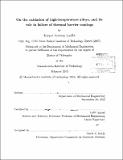| dc.contributor.advisor | Lallit Anand. | en_US |
| dc.contributor.author | Loeffel, Kaspar Andreas | en_US |
| dc.contributor.other | Massachusetts Institute of Technology. Department of Mechanical Engineering. | en_US |
| dc.date.accessioned | 2013-06-17T19:53:33Z | |
| dc.date.available | 2013-06-17T19:53:33Z | |
| dc.date.copyright | 2013 | en_US |
| dc.date.issued | 2013 | en_US |
| dc.identifier.uri | http://hdl.handle.net/1721.1/79290 | |
| dc.description | Thesis (Ph. D.)--Massachusetts Institute of Technology, Dept. of Mechanical Engineering, 2013. | en_US |
| dc.description | Cataloged from PDF version of thesis. | en_US |
| dc.description | Includes bibliographical references (p. 114-122). | en_US |
| dc.description.abstract | Thermal barrier coating (TBC) systems are applied to superalloy turbine blades to provide thermal insulation and oxidation protection. A TBC system consists of (a) an outer oxide layer that imparts thermal insulation, and (b) a metallic layer that affords oxidation protection for the substrate through the formation of a second, protective oxide layer. This slow oxidation of the metallic layer controls the mechanical integrity of the TBC system since it is accompanied by a large, anisotropic volumetric change on the order of 30 percent. To describe this coupled process at the microscale, in this thesis we formulate a continuum-level, chemo-thermo-mechanically coupled, thermodynamically-consistent theory which integrates (a) diffusion of oxygen, (b) oxidation with accompanying anisotropic volume change, (c) thermo-elasto-viscoplastic deformations that may be locally large, and (d) transient heat conduction. We numerically implement our theory in an implicit finite-element program, and calibrate the material parameters in our theory for an FeCrAlY alloy experimentally studied in the literature. We simulate the high-temperature oxidation of FeCrAlY, and show that our theory is capable of reproducing with reasonable accuracy the oxide thickness evolution with time at different temperatures, the shape distortion of the specimens, as well as the development of large compressive residual stresses in the protective surface oxide which forms. For the consideration of failure of thermal-barrier-coated components at the macroscale, a limitation of this type of model is that numerical simulations become challenging due to the sub-micron resolution of the required mesh. In a second part of this thesis, we therefore present a framework that facilitates macroscopic simulations by noting that the macroscopic effect of oxidation is simply to degrade some mechanical properties in the TBC system. In this framework oxidation is thus not modeled explicitly, but only indirectly manifested by affecting failure-related material parameters. We implement this model in an explicit finite-element program, apply it to a plasma-sprayed TBC system, and calibrate the material parameters. We then show that the model is capable of predicting with reasonable accuracy the load at which crack initiation occurs in a notched four-point bend test experimentally studied in the literature, as well as the overall qualitative load-displacement behavior in this test. | en_US |
| dc.description.statementofresponsibility | by Kaspar Andreas Loeffel. | en_US |
| dc.format.extent | 198 p. | en_US |
| dc.language.iso | eng | en_US |
| dc.publisher | Massachusetts Institute of Technology | en_US |
| dc.rights | M.I.T. theses are protected by
copyright. They may be viewed from this source for any purpose, but
reproduction or distribution in any format is prohibited without written
permission. See provided URL for inquiries about permission. | en_US |
| dc.rights.uri | http://dspace.mit.edu/handle/1721.1/7582 | en_US |
| dc.subject | Mechanical Engineering. | en_US |
| dc.title | On the oxidation of high-temperature alloys, and its role in failure of thermal barrier coatings | en_US |
| dc.type | Thesis | en_US |
| dc.description.degree | Ph.D. | en_US |
| dc.contributor.department | Massachusetts Institute of Technology. Department of Mechanical Engineering | |
| dc.identifier.oclc | 846912516 | en_US |
